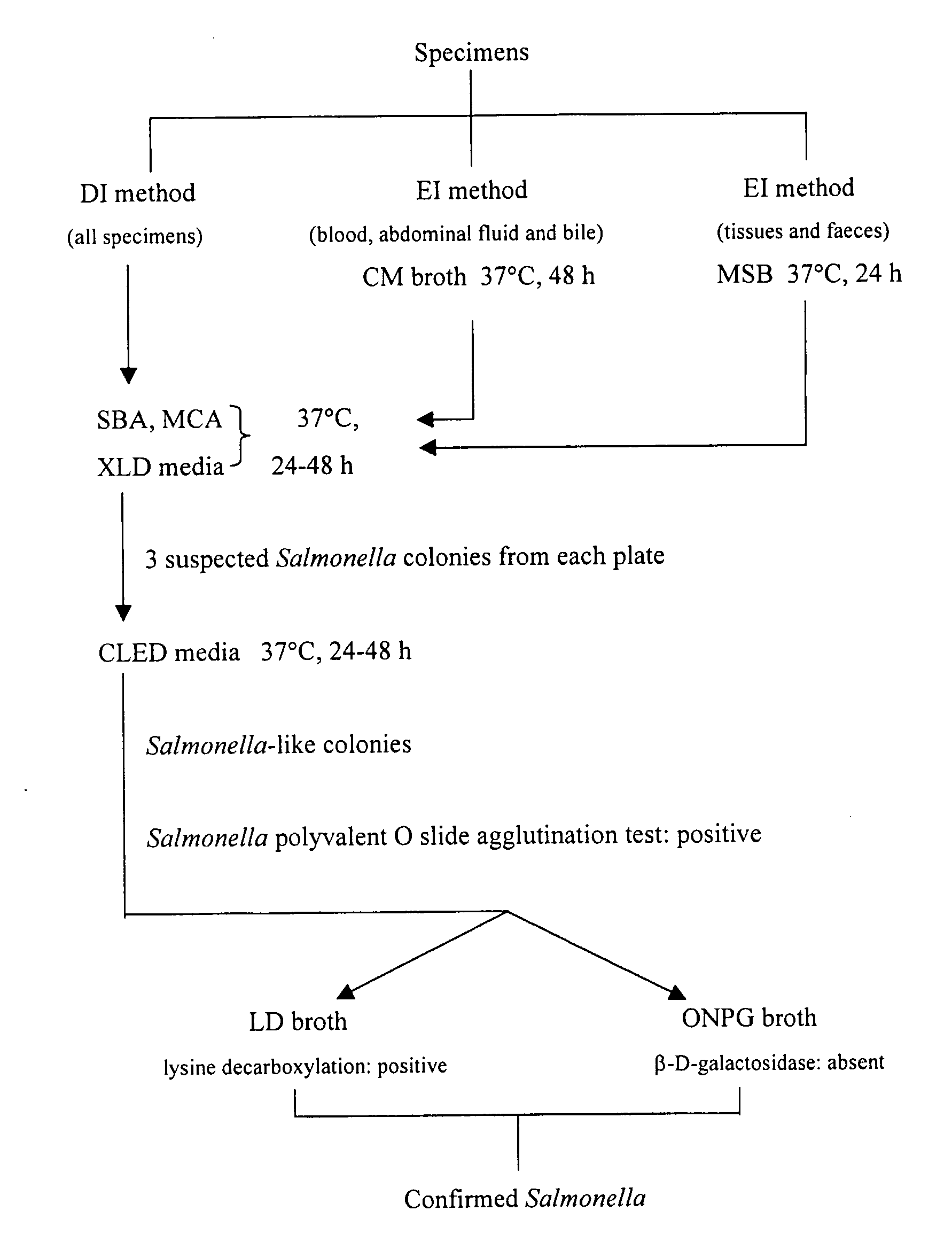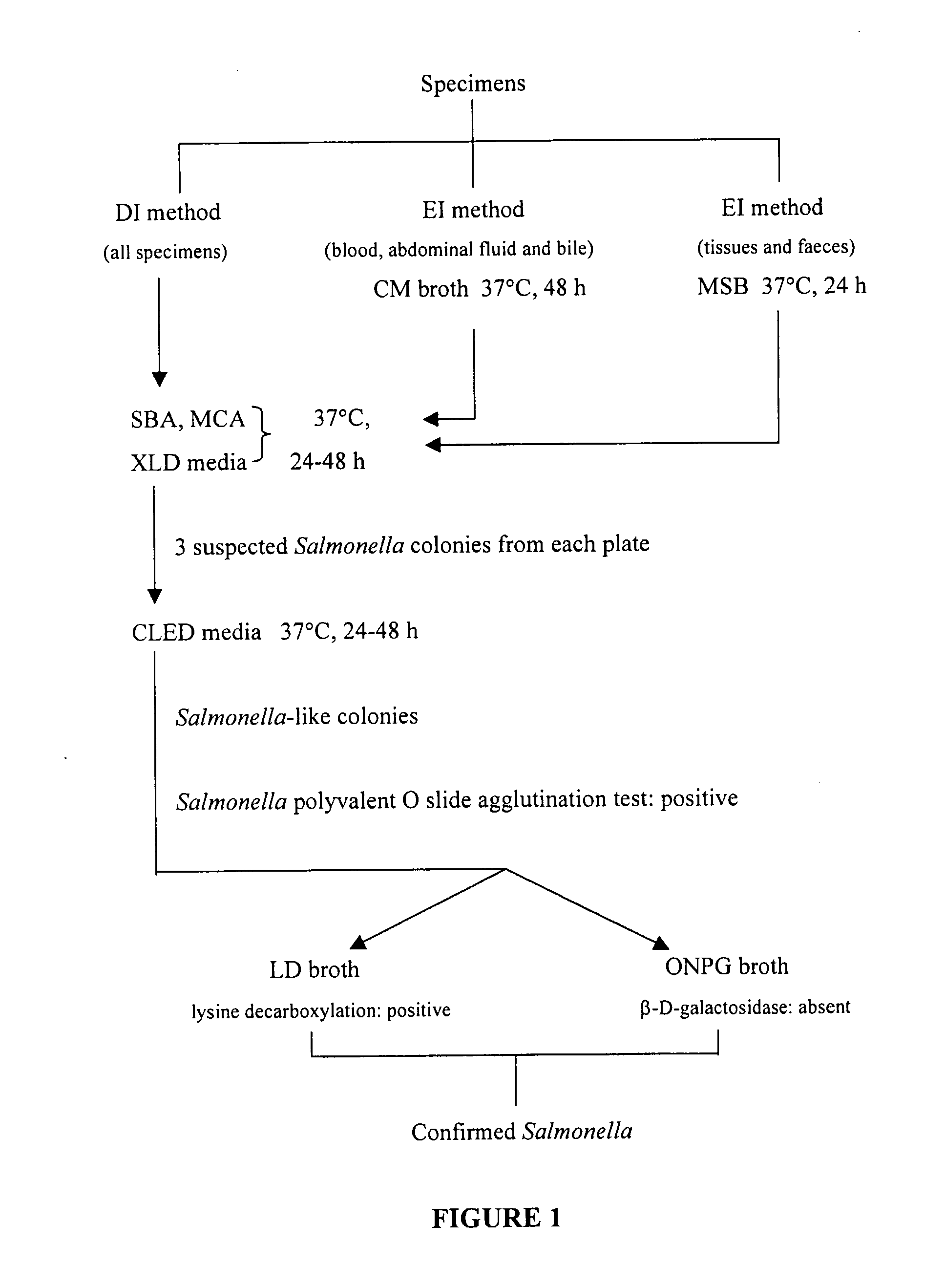Live Attenuated Salmonella For Use as Vaccine
a technology of attenuated salmonella and vaccine, which is applied in the field of therapeutic agents, can solve the problems of salmonellosis still a major problem in both developed and developing countries, the response is ineffective against pathogens, and the protection wears off, so as to facilitate the selection of substantially attenuated salmonella, prevent infection and spontaneous abortion, and improve the effect of protection
- Summary
- Abstract
- Description
- Claims
- Application Information
AI Technical Summary
Benefits of technology
Problems solved by technology
Method used
Image
Examples
example 1
General Experimental Procedures
[0099]The following experimental procedures are used in the subsequent examples which follow:
Materials
[0100]A S. dublin wild strain FD436 was obtained from the Department of Primary Industries' Animal Research Institute (ARI) and was used to generate metabolic-drift mutants. It was also the challenge strain used in mouse inoculation studies. This organism was the causative organism of an outbreak of salmonellosis in Beaudesert, Queensland, Australia in 1998.
Chemicals
[0101]All chemicals were used in accordance with the manufacturer's recommendations. Information in square brackets indicates catalogue numbers of products.
Commercial Chemicals
Ajax Laboratory Chemicals (Ajax), New South Wales (NSW), Australia:
[0102]Glycerol, Sodium hydroxide pellets (analytical reagent (AR))
BDH Chemicals (BDH), Victoria, Australia:
[0103]Acetic acid, Bromophenol blue, Ethanol, Glycine, Hydrochloric acid (HCl) sp.gr.1.18 (AR), Methanol 99.8 atom %, Sodium hydrogen car...
example 2
Results for Example 2
MIC and MBC Determination for FD436
MIC and MBC of Nalidixic Acid:
[0152]Through turbidity measurements obtained with Bioscreen and direct observation, the MIC of nalidixic acid for FD436 was determined to be 0.00125% (w / v) (Table 3). The MBC was also determined to be 0.00125% (w / v) as profuse growth (greater than 1.0×103 colonies) of Salmonella was observed on SBA plates streaked with TSB media originally containing equal to or less than 0.000625% (w / v) of nalidixic acid. Only small numbers of colonies or no colonies at all were found on SBA plates streaked with TSB media originally containing equal to or greater than 0.00125% (w / v) of the antimicrobial (Table 4).
MIC and MBC of Rifampicin:
[0153]Through testing with Bioscreen and direct observation, the MIC of rifampicin for FD436 was determined to be 0.0025% (w / v) (Table 3). The MBC was also determined to be 0.0025% (w / v) (Table 4).
TABLE 3TURBIDITY OF TSB MEDIA CONTAINING NALIDIXIC ACID ORRIFAMPICIN AFTER 24-HOUR...
experimental procedures
for Example 3
[0160]FD436 and the 8 selected double antimicrobial-resistant strains N-RM4, 8, 9, 15, 20, 25, and 27 and R-NM29 were prepared following the procedure described previously.
Genotyping Characterization:
[0161]Genotypic characterisation of FD436 and the double antimicrobial-resistant strains prepared as above was performed. To investigate the stability of the identified mutations, characterisation of the strains was repeated following subculturing 15 times on SBA (each subculture was incubated at 37° C. for 48 h).
PCR amplification of S. dublin gyrA Genes:
[0162]A portion of the gyrA gene (expected approximate size 347 base pairs (bp) (Griggs et al., Antimicrobial Agents and Chemotherapy 40:1009-1013, 1996) encompassing the QRDR region was amplified by PCR for FD436 and the 8 mutant strains using 20-mer oligonucleotide primers, SALGYRA-F and SALGYRA-R (synthesized by Genset Pacific Pty., Ltd., Lismore, Australia). The primer sequences were as follows—SALGYRA-F=5′-TGT...
PUM
| Property | Measurement | Unit |
|---|---|---|
| pH | aaaaa | aaaaa |
| total volume | aaaaa | aaaaa |
| total volume | aaaaa | aaaaa |
Abstract
Description
Claims
Application Information
 Login to View More
Login to View More - R&D
- Intellectual Property
- Life Sciences
- Materials
- Tech Scout
- Unparalleled Data Quality
- Higher Quality Content
- 60% Fewer Hallucinations
Browse by: Latest US Patents, China's latest patents, Technical Efficacy Thesaurus, Application Domain, Technology Topic, Popular Technical Reports.
© 2025 PatSnap. All rights reserved.Legal|Privacy policy|Modern Slavery Act Transparency Statement|Sitemap|About US| Contact US: help@patsnap.com



